A Literature Review on the Use of Recycled Construction and Demolition Materials in Unbound Pavement Applications
Abstract
:1. Introduction
2. State of Play in the European Union
2.1. European Union Legislation on C&D Waste
2.2. Composition of C&D Waste
- Increased diversion rate of C&D wastes from landfill and consequent land use preservation;
- Valorisation of waste as secondary raw materials consequently reducing the need for primary raw materials;
- Enhanced environmental protection both at the local and global scale by reducing waste landfilling and the use of new materials;
- Reduction in overall demolition costs through landfill charge savings and revenues from the sale of secondary raw materials.
2.3. Recovering Rates of C&D Waste
- Landfill prices are low and the penalties for contravention are generally small or non-existent;
- Available raw materials offer sufficient quality at a moderate cost, and therefore, the recycled C&D materials industry is not really established in the market (low-cost of raw materials is a fierce competition with recycled materials);
- Inadequate C&D waste management models. Although some countries have introduced preventive measures for the recovery of waste materials, several years ago, the C&D waste generated in some EU countries was still dumped in legal or illegal landfills.
2.4. Use of C&D Waste towards a Circular Economy in the Construction Industry
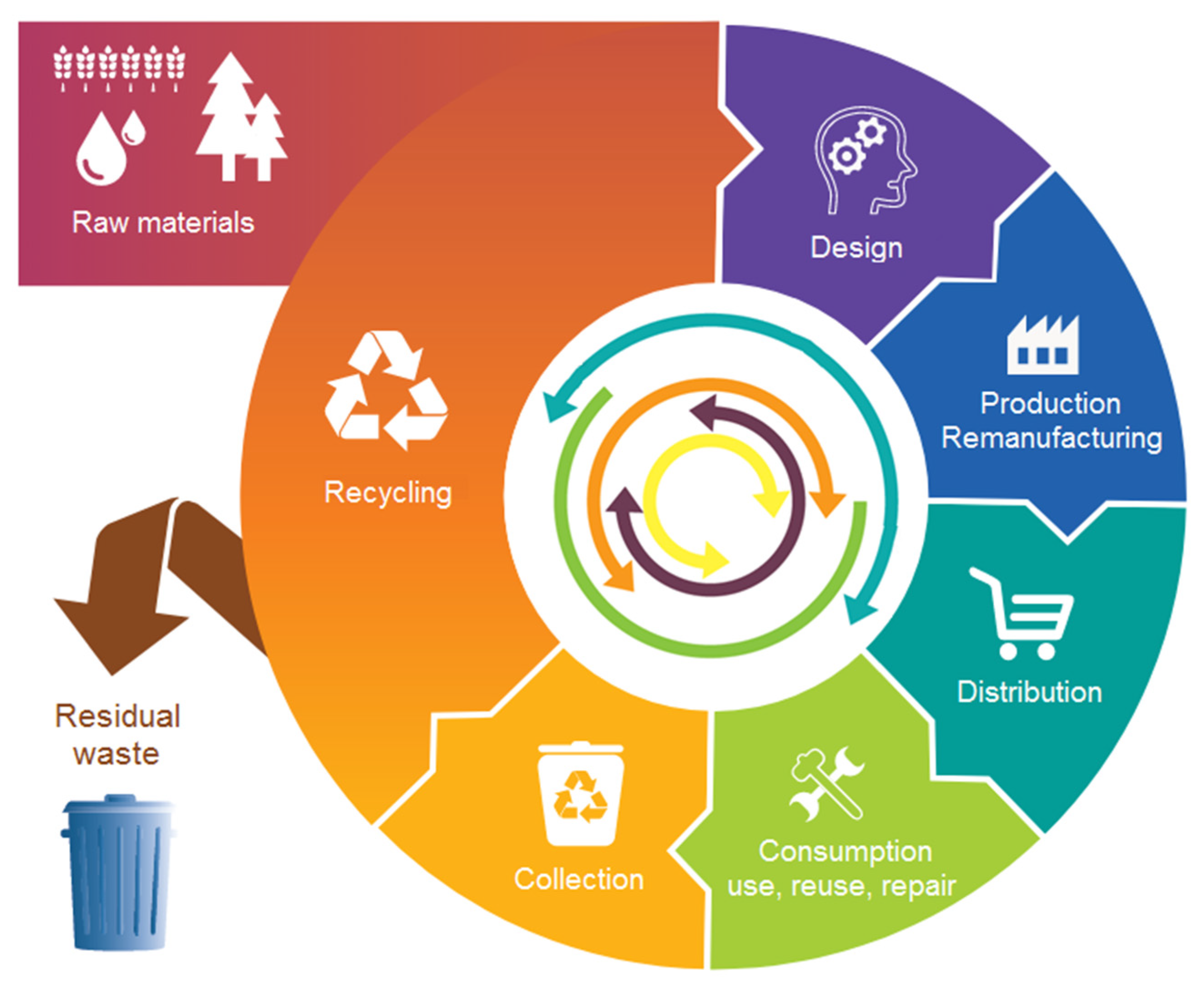
3. Applications and Relevant Properties of Recycled C&D Materials
3.1. Main Applications
3.2. Physical, Mechanical, Chemical and Geotechnical Properties of Recycled C&D Materials
3.3. Durability of Recycled Aggregates
3.3.1. Permeability
3.3.2. Soundness
3.3.3. Freeze–Thaw Resistance
3.3.4. Other Studies Related with Long-Term Behaviour of Recycled Aggregates
3.4. Environmental Risk
4. Field Studies of Unbound Pavement Applications
4.1. Case Studies
4.2. International Roughness Index
4.3. Deflection
5. Conclusions
- In general, recycled aggregates are suitable alternatives to natural aggregates in unbound pavement layers and other geotechnical applications.
- When RAP is used, the permeability tends to decrease, possibly due to the presence of impermeable bituminous particles.
- RCA tends to show a lower resistance to freeze–thaw cycles than natural aggregates; however, this resistance is strongly dependent on the quality of the RCA.
- The use of RCA in pavements may not be allowed where very low temperatures are expected, as their performance (shear strength and stiffness) can be affected.
- The performance of RCA is commonly lower than that of natural aggregates regarding the exposure to environments with high sulphate concentrations.
- The IRI deflectometer tests have shown that the performance of sub-base and base layers built with RCA can be equal to or even better than that of the layers constructed with natural aggregates. It was also found that, over time, natural aggregate surface layers tend to show higher IRI increases than those of RCA surface layers, which means that RCA may provide a longer pavement structural life.
Author Contributions
Funding

Institutional Review Board Statement
Informed Consent Statement
Data Availability Statement
Conflicts of Interest
References
- Eurostat. Material Flow Accounts and Resource Productivity. Available online: https://ec.europa.eu/eurostat/statistics-explained/index.php/Material_flow_accounts_and_resource_productivity (accessed on 15 September 2022).
- Eurostat. Waste Statistics. Available online: https://ec.europa.eu/eurostat/statistics-explained/index.php?title=Waste_statistics (accessed on 15 September 2022).
- Luu, N.C.; Nguyen, L.H.; Tran, T.V.N.; Isobe, Y.; Kawasaki, M.; Kawamoto, K. Construction and Demolition Waste Illegal Dumping: Environmental, Social and Economic Impacts Assessment for A Growing City. Jpn. Geotech. Soc. Spec. Publ. 2021, 9, 148–155. [Google Scholar] [CrossRef]
- Da Paz, D.H.F.; Lafayette, K.P.V.; Holanda, M.J.D.O.; Sobral, M.D.C.M.; Costa, L.A.R.D.C. Assessment of environmental impact risks arising from the illegal dumping of construction waste in Brazil. Environ. Dev. Sustain. 2018, 22, 2289–2304. [Google Scholar] [CrossRef]
- Hansen, T.C. Recycling of Demolished Concrete and Masonry; CRC Press: London, UK, 1992. [Google Scholar]
- European Comission (DG ENV). European Commission Directorate-General for Environment, Service Contract on Management of Construction and Demolition Waste SR1 Final Report. Task 2-Study; EU Publications: Brussels, Belgium, 2011; Available online: https://ec.europa.eu/environment/waste/pdf/2011_CDW_Report.pdf (accessed on 15 September 2022).
- Vieira, C.S.; Pereira, P.M. Use of recycled construction and demolition materials in geotechnical applications: A review. Resour. Conserv. Recycl. 2015, 103, 192–204. [Google Scholar] [CrossRef]
- Dipanjan, B.; Aditi, M.; Puppala, A.J. Sustainability and geotechnical engineering: Perspectives and review. Can. Geotech. J. 2015, 52, 96–113. [Google Scholar]
- Correia, A.G.; Winter, M.G.; Puppala, A.J. A review of sustainable approaches in transport infrastructure geotechnics. Transp. Geotech. 2016, 7, 21–28. [Google Scholar] [CrossRef] [Green Version]
- Dhir, R.K.; de Brito, J.; Silva, R.V.; Lye, C.Q. Sustainable Construction Materials: Recycled Aggregates, 1st ed.; Woodhead Publishing: Cambridge, UK, 2019; p. 652. [Google Scholar]
- Rao, A.; Jha, K.N.; Misra, S. Use of aggregates from recycled construction and demolition waste in concrete. Resour. Conserv. Recycl. 2007, 50, 71–81. [Google Scholar] [CrossRef]
- Evangelista, L.; de Brito, J. Durability performance of concrete made with fine recycled concrete aggregates. Cem. Concr. Compos. 2010, 32, 9–14. [Google Scholar] [CrossRef]
- Barbudo, A.; de Brito, J.; Evangelista, L.; Bravo, M.; Agrela, F. Influence of water-reducing admixtures on the mechanical performance of recycled concrete. J. Clean. Prod. 2013, 59, 93–98. [Google Scholar] [CrossRef]
- Bravo, M.; de Brito, J.; Pontes, J.; Evangelista, L. Durability performance of concrete with recycled aggregates from construction and demolition waste plants. Constr. Build. Mater. 2015, 77, 357–369. [Google Scholar] [CrossRef]
- MRahman, A.; Imteaz, M.; Arulrajah, A.; Disfani, M.M. Suitability of recycled construction and demolition aggregates as alternative pipe backfilling materials. J. Clean. Prod. 2014, 66, 75–84. [Google Scholar] [CrossRef]
- Vieira, C.; Lopes, M.; Cristelo, N. Geotechnical characterization of recycled C&D wastes for use as trenches backfilling. In The 4th Edition of the International Conference Wastes: Solutions, Treatments and Opportunities; CRC Press: Porto, Portugal, 2017; pp. 175–181. [Google Scholar]
- Bennert, T.; Papp, W.J., Jr.; Maher, A.; Gucunski, N. Utilization of construction and demolition debris under traffic-type loading in base and subbase applications. Transp. Res. Rec. 2000, 1714, 33–39. [Google Scholar] [CrossRef]
- Poon, C.S.; Chan, D. Feasible use of recycled concrete aggregates and crushed clay brick as unbound road sub-base. Constr. Build. Mater. 2006, 20, 578–585. [Google Scholar] [CrossRef]
- Vegas, I.; Ibañez, J.A.; José, J.T.S.; Urzelai, A. Construction demolition wastes, Waelz slag and MSWI bottom ash: A comparative technical analysis as material for road construction. Waste Manag. 2008, 28, 565–574. [Google Scholar] [CrossRef]
- Barbudo, A.; Agrela, F.; Ayuso, J.; Jiménez, J.R.; Poon, C.S. Statistical analysis of recycled aggregates derived from different sources for sub-base applications. Constr. Build. Mater. 2012, 28, 129–138. [Google Scholar] [CrossRef]
- Neves, J.; Freire, A.; Roque, A.; Martins, I.; Antunes, M.; Faria, G. Utilization of recycled materials in unbound granular layers validated by experimental test sections. In Proceedings of the International Conference on the Bearing Capacity of Roads, Railways and Airfields, Trondheim, Norway, 25–27 June 2013; pp. 821–829. [Google Scholar]
- Arulrajah, A.; Piratheepan, J.; Disfani, M.M.; Bo, M.W. Geotechnical and Geoenvironmental Properties of Recycled Construction and Demolition Materials in Pavement Subbase Applications. J. Mater. Civ. Eng. 2013, 25, 1077–1088. [Google Scholar] [CrossRef]
- Cristelo, N.; Vieira, C.S.; de Lurdes Lopes, M. Geotechnical and Geoenvironmental Assessment of Recycled Construction and Demolition Waste for Road Embankments. Procedia Eng. 2016, 143, 51–58. [Google Scholar] [CrossRef] [Green Version]
- Bassani, M.; Tefa, L.; Russo, A.; Palmero, P. Alkali-activation of recycled construction and demolition waste aggregate with no added binder. Constr. Build. Mater. 2019, 205, 398–413. [Google Scholar] [CrossRef]
- Directive 2008/98/EC; Directive 2008/98/EC of the European Parliament and of the Council of 19 November 2008 on waste and repealing certain Directives. Official Journal of the European Union L 312/3: Maastricht, The Netherlands, 19 November 2008.
- Mália, M.; de Brito, J.; Pinheiro, M.D.; Bravo, M. Construction and demolition waste indicators. Waste Manag. Res. 2013, 31, 241–255. [Google Scholar] [CrossRef]
- Hjelmar, O.; Hansen, J.B.; Wahlström, M.; Wik, O. End-of-Waste Criteria for Construction & Demolition Waste; Nordic Council of Ministers: Copenhagen, Denmark, 2016. [Google Scholar]
- European Comission. EU Construction & Demolition Waste Management Protocol. 2016. Available online: https://ec.europa.eu/growth/content/eu-construction-and-demolition-waste-protocol-0_en (accessed on 15 September 2022).
- Decision 2000/532/EC; Commission Decision 2000/532/EC: Commission Decision of 3 May 2000 Replacing Decision 94/3/EC Establishing a List of Wastes Pursuant to Article 1(a) of Council Directive 75/442/EEC on Waste and Council Decision 94/904/EC Establishing a List of Hazardous Waste Pursuant to Article 1(4) of Council Directive 91/689/EEC on Hazardous Waste. Official Journal of the European Union L 226/3: Maastricht, The Netherlands, 2000.
- Decision 2014/955/EU; Commission Decision 2014/955/EU: Commission Decision of 18 December 2014 Amending Decision 2000/532/EC on the List of Waste Pursuant to Directive 2008/98/EC of the European Parliament and of the Council. Official Journal of the European Union L 370/44: Maastricht, The Netherlands, 2014.
- Coelho, A.; de Brito, J. Economic analysis of conventional versus selective demolition—A case study. Resour. Conserv. Recycl. 2011, 55, 382–392. [Google Scholar] [CrossRef]
- Andersen, R.; Ravn, A.S.; Ryberg, M.W. Environmental benefits of applying selective demolition to buildings: A case study of the reuse of façade steel cladding. Resour. Conserv. Recycl. 2022, 184, 106430. [Google Scholar] [CrossRef]
- European Environment Agency (EEA). ETC/WMGE Report 1/2020: Construction and Demolition Waste: Challenges and Opportunities in a Circular Economy. European Environment Agency. 2020. Available online: https://www.eea.europa.eu/publications/construction-and-demolition-waste-challenges (accessed on 20 September 2022).
- European Environment Agency (EEA). Circular economy in Europe-Developing the knowledge base Waste prevention in Europe, EEA Report No 2/2016. European Environment Agency. 2016. Available online: https://www.eea.europa.eu/publications/circular-economy-in-europe (accessed on 20 September 2022).
- Baldassarre, B.; Schepers, M.; Bocken, N.; Cuppen, E.; Korevaar, G.; Calabretta, G. Industrial Symbiosis: Towards a design process for eco-industrial clusters by integrating Circular Economy and Industrial Ecology perspectives. J. Clean. Prod. 2019, 216, 446–460. [Google Scholar] [CrossRef]
- European Comission. Communication from the Commission to the European Parliament, the Council, the European Economic and Social Committee and the Committee of the Regions-Towards a Circular Economy: A Zero Waste Programme for Europe COM/2014/0398 Final; EU Publications: Brussels, Belgium, 2014; Available online: https://ec.europa.eu/environment/circular-economy/pdf/circular-economy-communication.pdf (accessed on 20 September 2022).
- Bocken, N.M.P.; de Pauw, I.; Bakker, C.; van der Grinten, B. Product design and business model strategies for a circular economy. J. Ind. Prod. Eng. 2016, 33, 308–320. [Google Scholar] [CrossRef] [Green Version]
- European Comission. Communication from the Commission to the European Parliament, the Council, the European Economic and Social Committee and the Committee of the Regions-Closing the Loop-An EU Action Plan for the Circular Economy COM/2015/0614 Final; EU Publications: Brussels, Belgium, 2015; Available online: https://eur-lex.europa.eu/legal-content/EN/TXT/?uri=CELEX:52015DC0614 (accessed on 20 September 2022).
- European Comission. Guidelines for the Waste Audits before Demolition and Renovation Works of Buildings. 2018. Available online: https://ec.europa.eu/docsroom/documents/31521 (accessed on 20 September 2022).
- European Comission. Level(s)-European Framework for Sustainable Buildings. Available online: https://environment.ec.europa.eu/topics/circular-economy/levels_en (accessed on 20 September 2022).
- Uriarte-Miranda, M.-L.; Caballero-Morales, S.-O.; Martinez-Flores, J.-L.; Cano-Olivos, P.; Akulova, A.-A. Reverse Logistic Strategy for the Management of Tire Waste in Mexico and Russia: Review and Conceptual Model. Sustainability 2018, 10, 3398. [Google Scholar] [CrossRef] [Green Version]
- Correia, J.M.F.; Neto, G.C.D.O.; Leite, R.R.; da Silva, D. Plan to Overcome Barriers to Reverse Logistics in Construction and Demolition Waste: Survey of the Construction Industry. J. Constr. Eng. Manag. 2021, 147, 04020172. [Google Scholar] [CrossRef]
- Neto, G.C.O.; Correia, J.M. Environmental and economic advantages of adopting reverse logistics for recycling construction and demolition waste: A case study of Brazilian construction and recycling companies. Waste Manag. Res. 2019, 37, 176–185. [Google Scholar] [CrossRef] [PubMed]
- Bairagi, N.K.; Ravande, K.; Pareek, V.K. Behaviour of concrete with different proportions of natural and recycled aggregates. Resour. Conserv. Recycl. 1993, 9, 109–126. [Google Scholar] [CrossRef]
- Brito, J.; Pereira, A.S.; Correia, J.R. Mechanical behaviour of non-structural concrete made with recycled ceramic aggregates. Cem. Concr. Compos. 2005, 27, 429–433. [Google Scholar] [CrossRef]
- Martín-Morales, M.; Zamorano, M.; Ruiz-Moyano, A.; Valverde-Espinosa, I. Characterization of recycled aggregates construction and demolition waste for concrete production following the Spanish Structural Concrete Code EHE-08. Constr. Build. Mater. 2011, 25, 742–748. [Google Scholar] [CrossRef]
- Chini, A.R.; Kuo, S.S.; Armaghani, J.M.; Duxbury, J.P. Test of recycled concrete aggregate in accelerated test track. J. Transp. Eng. 2001, 127, 486–492. [Google Scholar] [CrossRef]
- Park, T. Application of Construction and Building Debris as Base and Subbase Materials in Rigid Pavement. J. Transp. Eng. 2003, 129, 558–563. [Google Scholar] [CrossRef]
- Arulrajah, A.; Piratheepan, J.; Disfani, M.M.; Bo, M.W. Resilient Moduli Response of Recycled Construction and Demolition Materials in Pavement Subbase Applications. J. Mater. Civ. Eng. 2013, 25, 1920–1928. [Google Scholar] [CrossRef]
- Mohammadinia, A.; Arulrajah, A.; Sanjayan, J.; Mahdi, M.D.; Myint, W.B.; Darmawan, S. Laboratory Evaluation of the Use of Cement-Treated Construction and Demolition Materials in Pavement Base and Subbase Applications. J. Mater. Civ. Eng. 2015, 27, 04014186. [Google Scholar] [CrossRef]
- Cristelo, N.; Fernández-Jiménez, A.; Vieira, C.; Miranda, T.; Palomo, Á. Stabilisation of construction and demolition waste with a high fines content using alkali activated fly ash. Constr. Build. Mater. 2018, 170, 26–39. [Google Scholar] [CrossRef]
- Santos, E.C.G.; Palmeira, E.M.; Bathurst, R.J. Behaviour of a geogrid reinforced wall built with recycled construction and demolition waste backfill on a collapsible foundation. Geotext. Geomembr. 2013, 39, 9–19. [Google Scholar] [CrossRef]
- Vieira, C.S.; Pereira, P.M. Damage induced by recycled Construction and Demolition Wastes on the short-term tensile behaviour of two geosynthetics. Transp. Geotech. 2015, 4, 64–75. [Google Scholar] [CrossRef]
- Vieira, C.S.; Pereira, P.M.; Lopes, M.D.L. Recycled Construction and Demolition Wastes as filling material for geosynthetic reinforced structures. Interface properties. J. Clean. Prod. 2016, 124, 299–311. [Google Scholar] [CrossRef]
- Vieira, C.S.; Ferreira, F.B.; Pereira, P.M.; Lopes, M.D.L. Pullout behaviour of geosynthetics in a recycled construction and demolition material – Effects of cyclic loading. Transp. Geotech. 2020, 23, 100346. [Google Scholar] [CrossRef]
- Yeung, A.T.; Mok, K.Y.; Tham, L.G.; Lee, P.K.K.; Pei, G. Use of inert C&D materials for seawall foundation: A field-scale pilot test. Resour. Conserv. Recycl. 2006, 47, 375–393. [Google Scholar]
- Cassia, A.R.; Costa, I.; da Silva, V.H.C.; de Oliveira Neto, G.C. Systematic literature review for the development of a conceptual model on the relationship between knowledge sharing, information technology infrastructure and innovative capability. Technol. Anal. Strateg. Manag. 2020, 32, 801–821. [Google Scholar] [CrossRef]
- O’Mahony, M.M.; Milligan, G.W.E. Use of recycled materials in subbase layers. Transp. Res. Rec. 1991, 1310, 73–80. [Google Scholar]
- Nataatmadja, A.; Tan, Y.L. Resilient Response of Recycled Concrete Road Aggregates. J. Transp. Eng. 2001, 127, 450–453. [Google Scholar] [CrossRef] [Green Version]
- Touahamia, M.; Sivakumar, V.; McKelvey, D. Shear strength of reinforced-recycled material. Constr. Build. Mater. 2002, 16, 331–339. [Google Scholar] [CrossRef]
- Chen, H.-J.; Yen, T.; Chen, K.-H. Use of building rubbles as recycled aggregates. Cem. Concr. Res. 2003, 33, 125–132. [Google Scholar] [CrossRef]
- Aqil, U.; Tatsuoka, F.; Uchimura, T.; Lohani, T.N.; Tomita, Y.; Matsushima, K. Strength and deformation characteristics of recycled concrete aggregate as a backfill material. Soils Found. 2005, 45, 53–72. [Google Scholar] [CrossRef] [Green Version]
- Blankenagel, B.J. Characterization of Recycled Concrete for Use as Pavement Base Material. Master’s Thesis, Brigham Young University, Provo, UT, USA, 2005. [Google Scholar]
- Poon, C.-S.; Qiao, X.C.; Chan, D. The cause and influence of self-cementing properties of fine recycled concrete aggregates on the properties of unbound sub-base. Waste Manag. 2006, 26, 1166–1172. [Google Scholar] [CrossRef] [PubMed]
- Lancieri, F.; Marradi, A.; Mannucci, S. C&D waste for road construction: Long time performance of roads constructed using recycled aggregate for unbound pavement layers. In Waste Management and the Environment III; WIT Press: Southampton, UK, 2006; Volume 92, pp. 559–569. [Google Scholar]
- Rathje, E.M.; Rauch, A.F.; Trejo, D.; Folliard, K.J.; Viyanant, C.; Esfellar, M.; Jain, A.; Ogalla, M. Evaluation of Crushed Concrete and Recycled Asphalt Pavement as Backfill for Mechanically Stabilized Earth Walls; CTR Technical Report 0-4177-3; Center for Transportation Research the University of Texas at Austin: Austin, TX, USA, 2006. [Google Scholar]
- Ho, N.Y.; Lee, Y.P.K.; Tan, J.Y. Beneficial use of recycled concrete aggregate for road construction in Singapore. In Proceedings of the 6th International Conference on Road and Airfield Pavement Technology (ICPT), Sapporo, Japan, 20–23 July 2008; p. 8. [Google Scholar]
- Saeed, A.; Hammons, M.I. Use of Recycled Concrete as Unbound Base Aggregate in Airfield and Highway Pavements to Enhance Sustainability. In Airfield and Highway Pavements 2008; ASCE Labrary: Reston, VA, USA, 2008; pp. 497–508. [Google Scholar]
- Tam, V.W.Y.; Wang, K.; Tam, C.M. Assessing relationships among properties of demolished concrete, recycled aggregate and recycled aggregate concrete using regression analysis. J. Hazard. Mater. 2008, 152, 703–714. [Google Scholar] [CrossRef] [PubMed] [Green Version]
- Chidiroglou, I.; Goodwin, A.; Laycock, L.; O’Flaherty, F. Physical properties of demolition waste material. Proc. Inst. Civ. Eng. J. Constr. Mater. 2008, 16, 97–103. [Google Scholar] [CrossRef] [Green Version]
- da Conceição Leite, F.; dos Santos Motta, R.; Vasconcelos, K.L.; Bernucci, L. Laboratory evaluation of recycled construction and demolition waste for pavements. Constr. Build. Mater. 2011, 25, 2972–2979. [Google Scholar] [CrossRef]
- Vegas, I.; Ibañez, J.A.; Lisbona, A.; de Cortazar, A.S.; Frías, M. Pre-normative research on the use of mixed recycled aggregates in unbound road sections. Constr. Build. Mater. 2011, 25, 2674–2682. [Google Scholar] [CrossRef]
- Jiménez, J.R.; Agrela, F.; Ayuso, J.; López, M. A comparative study of recycled aggregates from concrete and mixed debris as material for unbound road sub-base. Mater. Construcción 2011, 61, 302. [Google Scholar]
- Arulrajah, A.; Piratheepan, J.; Aatheesan, T.; Bo, M.W. Geotechnical Properties of Recycled Crushed Brick in Pavement Applications. J. Mater. Civ. Eng. 2011, 23, 1444–1452. [Google Scholar] [CrossRef]
- Cameron, D.; Azam, A.; Rahman, M. Recycled Clay Masonry and Recycled Concrete Aggregate Blends in Pavement. Presented at the GeoCongress 2012: State of the Art and Practice in Geotechnical Engineering, Oakland, California, United States. 2012. Available online: https://ascelibrary.org/doi/10.1061/9780784412121.158 (accessed on 30 June 2022).
- Arulrajah, A.; Jegatheesan, P.; Ali, M.M.Y.; Bo, M. Geotechnical Properties of Recycled Concrete Aggregate in Pavement Sub-Base Applications. Geotech. Test. J. 2012, 35, 743–751. [Google Scholar] [CrossRef]
- Barbudo, A.; Galvín, A.P.; Agrela, F.; Ayuso, J.; Jiménez, J.R. Correlation analysis between sulphate content and leaching of sulphates in recycled aggregates from construction and demolition wastes. Waste Manag. 2012, 32, 1229–1235. [Google Scholar] [CrossRef]
- Cooley, L.A.; Hornsby, H. Evaluation of Crushed Concrete Base Strength. Burns Cooley Dennis, Inc., Mississippi, USA, Tech Report FHWA/MS-DOT-RD-12-238. 2012. Available online: https://rosap.ntl.bts.gov/view/dot/26281 (accessed on 30 June 2022).
- Ashtiani, R.; Saeed, A. Laboratory Performance Characterization of Pavements Incorporating Recycled Materials. In Proceedings of the GeoCongress 2012: State of the Art and Practice in Geotechnical Engineering, Oakland, CA, USA, 25–29 March 2012; Available online: https://ascelibrary.org/doi/10.1061/9780784412121.163 (accessed on 30 June 2022).
- Galvín, A.P.; Ayuso, J.; Agrela, F.; Barbudo, A.; Jiménez, J.R. Analysis of leaching procedures for environmental risk assessment of recycled aggregate use in unpaved roads. Constr. Build. Mater. 2013, 40, 1207–1214. [Google Scholar] [CrossRef]
- Azam, A.M.; Cameron, D.A. Geotechnical Properties of Blends of Recycled Clay Masonry and Recycled Concrete Aggregates in Unbound Pavement Construction. J. Mater. Civ. Eng. 2013, 25, 788–798. [Google Scholar] [CrossRef]
- Azam, A.M.; Cameron, D.A.; Rahman, M.M. Model for prediction of resilient modulus incorporating matric suction for recycled unbound granular materials. Can. Geotech. J. 2013, 50, 1143–1158. [Google Scholar] [CrossRef]
- Rahman, M.A.; Arulrajah, A.; Piratheepan, J.; Bo, M.W.; Imteaz, M.A. Resilient Modulus and Permanent Deformation Responses of Geogrid-Reinforced Construction and Demolition Materials. J. Mater. Civ. Eng. 2014, 26, 512–519. [Google Scholar] [CrossRef]
- Arulrajah, A.; Disfani, M.M.; Horpibulsuk, S.; Suksiripattanapong, C.; Prongmanee, N. Physical properties and shear strength responses of recycled construction and demolition materials in unbound pavement base/subbase applications. Constr. Build. Mater. 2014, 58, 245–257. [Google Scholar] [CrossRef]
- Arulrajah, A.; Piratheepan, J.; Disfani, M.M. Reclaimed Asphalt Pavement and Recycled Concrete Aggregate Blends in Pavement Subbases: Laboratory and Field Evaluation. J. Mater. Civ. Eng. 2014, 26, 349–357. [Google Scholar] [CrossRef]
- Ayan, V.; Limbachiya, M.C.; Omer, J.R.; Azadani, S.M.N. Compaction assessment of recycled aggregates for use in unbound subbase application. J. Civ. Eng. Manag. 2014, 20, 169–174. [Google Scholar] [CrossRef] [Green Version]
- Soleimanbeigi, A.; Edil, T.B. Compressibility of Recycled Materials for Use As Highway Embankment Fill. J. Geotech. Geoenvironmental Eng. 2015, 141, 04015011. [Google Scholar] [CrossRef]
- MRahman, A.; Imteaz, M.A.; Arulrajah, A.; Piratheepan, J.; Disfani, M.M. Recycled construction and demolition materials in permeable pavement systems: Geotechnical and hydraulic characteristics. J. Clean. Prod. 2015, 90, 183–194. [Google Scholar] [CrossRef]
- Aydilek, A.H.; Haider, I.; Cetin, A.; Kaya, Z.; Hatipoglu, M. Development of design guidelines for proper selection of graded aggregate base in Maryland state highways. Maryland State Highway Administration, Baltimore MD, USA, Tech Report MD-15-SP109B4G-1. 2015. Available online: https://rosap.ntl.bts.gov/view/dot/28445 (accessed on 10 July 2022).
- Taherkhani, H. Evaluation of the physical properties of unbound base layer containing recycled aggregates. Int. J. Environ. Sci. Dev. 2015, 6, 279–285. [Google Scholar] [CrossRef] [Green Version]
- Taherkhani, H.; Valizadeh, M. An Investigation on the Effects of Aggregates Properties on the Performance of Unbound Aggregate Base Layer. Int. J. Transp. Eng. 2015, 3, 151–164. [Google Scholar]
- Soleimanbeigi, A.; Shedivy, R.F.; Tinjum, J.M.; Edil, T.B. Climatic effect on resilient modulus of recycled unbound aggregates. Road Mater. Pavement Des. 2015, 16, 836–853. [Google Scholar] [CrossRef]
- Bestgen, J.O.; Hatipoglu, M.; Cetin, B.; Aydilek, A.H. Mechanical and Environmental Suitability of Recycled Concrete Aggregate as a Highway Base Material. J. Mater. Civ. Eng. 2016, 28, 04016067. [Google Scholar] [CrossRef]
- Freire, A.C.; das Neves, J.M.C.; Roque, A.J.; Martins, I.M.; Antunes, M.D.L. Feasibility study of milled and crushed reclaimed asphalt pavement for application in unbound granular layers. Road Mater. Pavement Des. 2019, 22, 1500–1520. [Google Scholar] [CrossRef]
- Pereira, P.M.; Ferreira, F.B.; Vieira, C.S.; Lopes, M.L. Use of Recycled C&D Wastes in Unpaved Rural and Forest Roads - feasibility Analysis.. presented at the WASTES: Solutions, Treatments and Opportunities-Selected Papers from the 5th Edition of the International Conference on Wastes: Solutions, Treatments and Opportunities, 2019. Conference Paper. Available online: https://www.scopus.com/inward/record.uri?eid=2-s2.0-84949796241&partnerID=40&md5=d7cfc476b9c145ec38004f547015a39f (accessed on 10 July 2022).
- Soleimanbeigi, A.; Tanyu, B.F.; Aydilek, A.H.; Florio, P.; Abbaspour, A.; Dayioglu, A.Y.; Likos, W.J. Evaluation of recycled concrete aggregate backfill for geosynthetic-reinforced MSE walls. Geosynth. Int. 2019, 26, 396–412. [Google Scholar] [CrossRef]
- Głuchowski, A.; Sas, W.; Dzięcioł, J.; Soból, E.; Szymański, A. Permeability and Leaching Properties of Recycled Concrete Aggregate as an Emerging Material in Civil Engineering. Appl. Sci. 2018, 9, 81. [Google Scholar] [CrossRef] [Green Version]
- Look, B.G. Handbook of Geotechnical Investigation and Design Tables; CRC Press: London, UK, 2014. [Google Scholar]
- Barnes, G. Soil Mechanics: Principles and Practice; Bloomsbury Publishing: London, UK, 2017. [Google Scholar]
- Vieira, C.S.; Pereira, P.M. Interface shear properties of geosynthetics and construction and demolition waste from large-scale direct shear tests. Geosynth. Int. 2016, 23, 62–70. [Google Scholar] [CrossRef]
- Vieira, C.S.; Pereira, P.M. Use of Mixed Construction and Demolition Recycled Materials in Geosynthetic Reinforced Embankments. Indian Geotech. J. 2017, 48, 279–292. [Google Scholar] [CrossRef]
- Santos, E.C.G.; Palmeira, E.M.; Bathurst, R.J. Performance of two geosynthetic reinforced walls with recycled construction waste backfill and constructed on collapsible ground. Geosynth. Int. 2014, 21, 256–269. [Google Scholar] [CrossRef]
- Vieira, C.S.; Pereira, P.M. Influence of the Geosynthetic Type and Compaction Conditions on the Pullout Behaviour of Geosynthetics Embedded in Recycled Construction and Demolition Materials. Sustainability 2022, 14, 1207. [Google Scholar] [CrossRef]
- Pourkhorshidi, S.; Sangiorgi, C.; Torreggiani, D.; Tassinari, P. Using Recycled Aggregates from Construction and Demolition Waste in Unbound Layers of Pavements. Sustainability 2020, 12, 9386. [Google Scholar] [CrossRef]
- Oldecop, L.A.; Alonso, E.E. A model for rockfill compressibility. Geotechnique 2001, 51, 127–139. [Google Scholar] [CrossRef]
- Bennert, T.; Maher, A. The Use of Recycled Concrete Aggregate in a Dense Graded Aggregate Base Course. U.S. Department of Transportation Federal Highway Administration, New Jersey Department of Transportation, New Jersey, USA, Tech Report. 2008. Available online: https://rosap.ntl.bts.gov/view/dot/38119 (accessed on 10 July 2022).
- AASHTO. Guide for Design of Pavement Structures; American Association of State Highway Transportation Officials: Washington, DC, USA, 1993. [Google Scholar]
- Seferoğlu, A.G.; Seferoğlu, M.T.; Akpınar, M.V. Investigation of the Effect of Recycled Asphalt Pavement Material on Permeability and Bearing Capacity in the Base Layer. Adv. Civ. Eng. 2018, 2018, 6. [Google Scholar] [CrossRef] [Green Version]
- Bazaz, J.B.; Khayati, M.; Akrami, N. Performance of concrete produced with crushed bricks as the coarse and fine aggregate. In The Geological Society of London; Citeseer: State College, PA, USA, 2006; Volume 10. [Google Scholar]
- Diagne, M.; Tinjum, J.M.; Nokkaew, K. The effects of recycled clay brick content on the engineering properties, weathering durability, and resilient modulus of recycled concrete aggregate. Transp. Geotech. 2015, 3, 15–23. [Google Scholar] [CrossRef]
- ASTM D560/D560M-16; Standard Test Methods for Freezing and Thawing Compacted Soil-Cement Mixtures. ASTM International: West Conshohocken, PA, USA, 2016.
- EN 1367-1: 2007; Tests for Thermal and Weathering Properties of Aggregates. Determination of resistance to freezing and thawing. CEN: Brussels, Belgium, 2007.
- ASTM D6035/D6035M-19; Standard Test Methods for Determining the Effect of Freeze-Thaw on Hydraulic Conductivity of Compacted or Intact Soil Specimens Using a Flexible Wall Permeameter. ASTM International: West Conshohocken, PA, USA, 2019.
- Bassani, M.; Tefa, L. Compaction and freeze-thaw degradation assessment of recycled aggregates from unseparated construction and demolition waste. Constr. Build. Mater. 2018, 160, 180–195. [Google Scholar] [CrossRef]
- Domitrović, J.; Rukavina, T.; Lenart, S. Effect of freeze-thaw cycles on the resilient moduli and permanent deformation of RAP/natural aggregate unbound base mixtures. Transp. Geotech. 2018, 18, 83–91. [Google Scholar] [CrossRef]
- Pereira, P.M.; Vieira, C.; Lopes, M. Degradation assessment of recycled aggregates from Construction and Demolition Waste through wet-dry cycles. In Proceedings of the XXVII European Conference on Soil Mechanics and Geotechnical Engineering (XXVII ECSMGE), Reykjavik, Iceland, 1–6 September 2019. [Google Scholar]
- Li, Z.; Yan, S.; Liu, L.; Dai, B.; Dong, W. Long-Term Deformation Analysis of Recycled Construction Waste Subgrade Filler. Adv. Civ. Eng. 2019, 2019, 5891759. [Google Scholar] [CrossRef]
- EN 12457-3: 2002; Characterisation of Waste. Leaching. Compliance Test for Leaching of Granular Waste Materials and Sludges. Two Stage Batch Test at a Liquid to Solid Ratio of 2 l/kg and 8 l/kg for Materials with a High Solid Content and with a Particle Size Below 4 mm (without or with size reduction). CEN: Brussels, Belgium, 2002.
- Arm, M. Mechanical Properties of Residues as Unbound Road Materials-Experimental Tests on MSWI Bottom Ash, Crushed Concrete and Blast Furnace Slag in SGI Rapport. Stockholm03480755 (ISSN). 2003. Available online: http://urn.kb.se/resolve?urn=urn:nbn:se:swedgeo:diva-216 (accessed on 28 March 2019).
- Lee, Y.P.K.; Ho, N.Y.; Tan, J.Y.; Lee, K.K.; Foo, S.Y.; Ang, S.S.M. Beneficial use of recycled concrete aggregate for utility trench reinstatement. In Proceedings of the 7th International Conference on Road and Airfield Pavement Technology (ICPT), Bangkok, Thailand, 3–5 August 2011; p. 8. [Google Scholar]
- Jiménez, J.R.; Ayuso, J.; Agrela, F.; López, M.; Galvín, A.P. Utilisation of unbound recycled aggregates from selected CDW in unpaved rural roads. Resour. Conserv. Recycl. 2012, 58, 88–97. [Google Scholar] [CrossRef]
- Lee, K.; Ho, N.; Tan, J.; Yoong, C.; Lim, J.; Lee, K. Field study on the use of recycled concrete aggregate for road trenching works in Singapore. In Proceedings of the 2nd World Roads Conference, Singapore, 26–28 October 2009; p. 8. [Google Scholar]
- ASTM E1926-08; Standard Practice for Computing International Roughness Index of Roads from Longitudinal Profile Measurements. ASTM International: West Conshohocken, PA, USA, 2015.
- ASTM E1364-95; Standard Test Method for Measuring Road Roughness by Static Level Method. ASTM International: West Conshohocken, PA, USA, 2017.
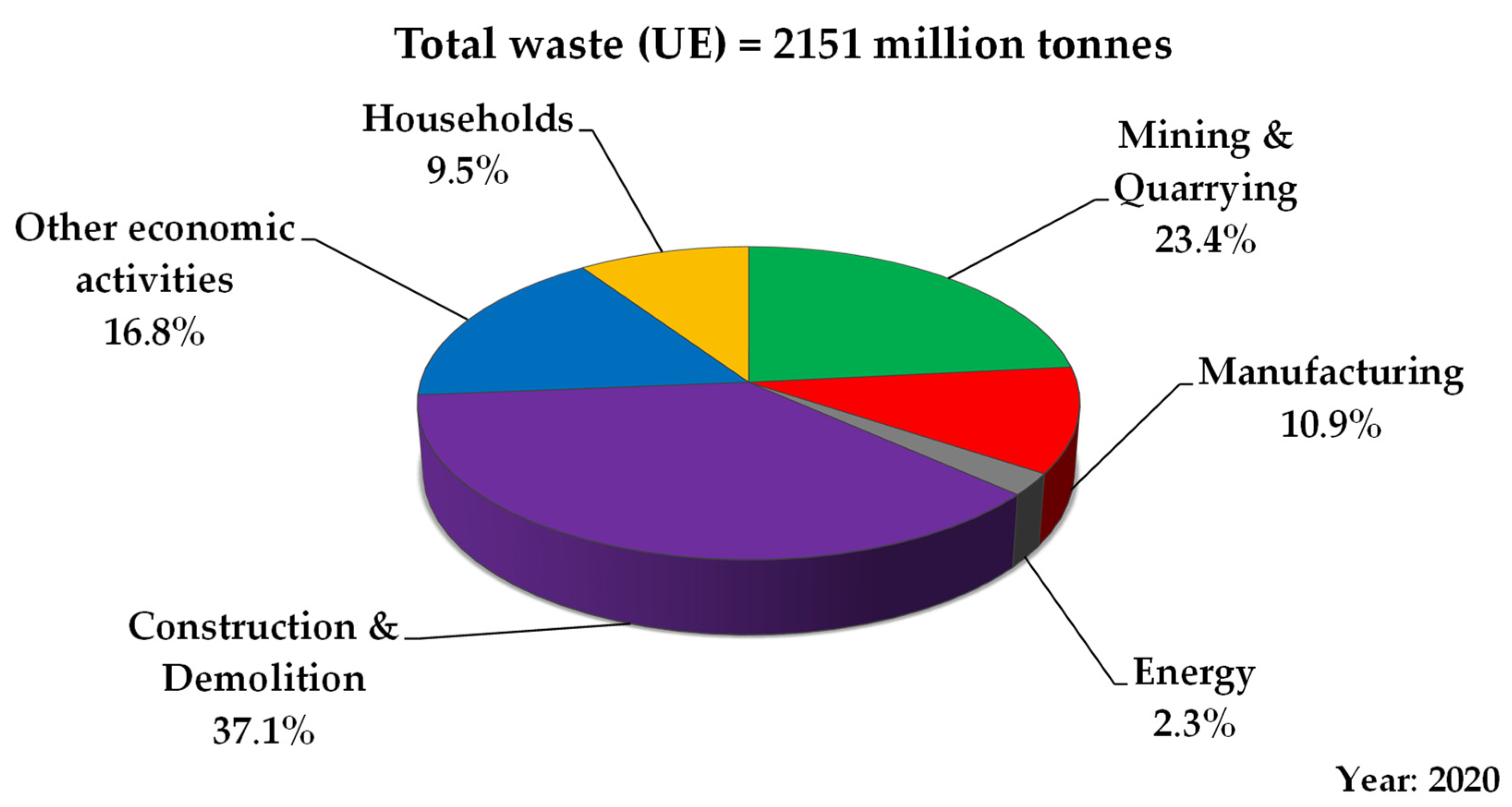
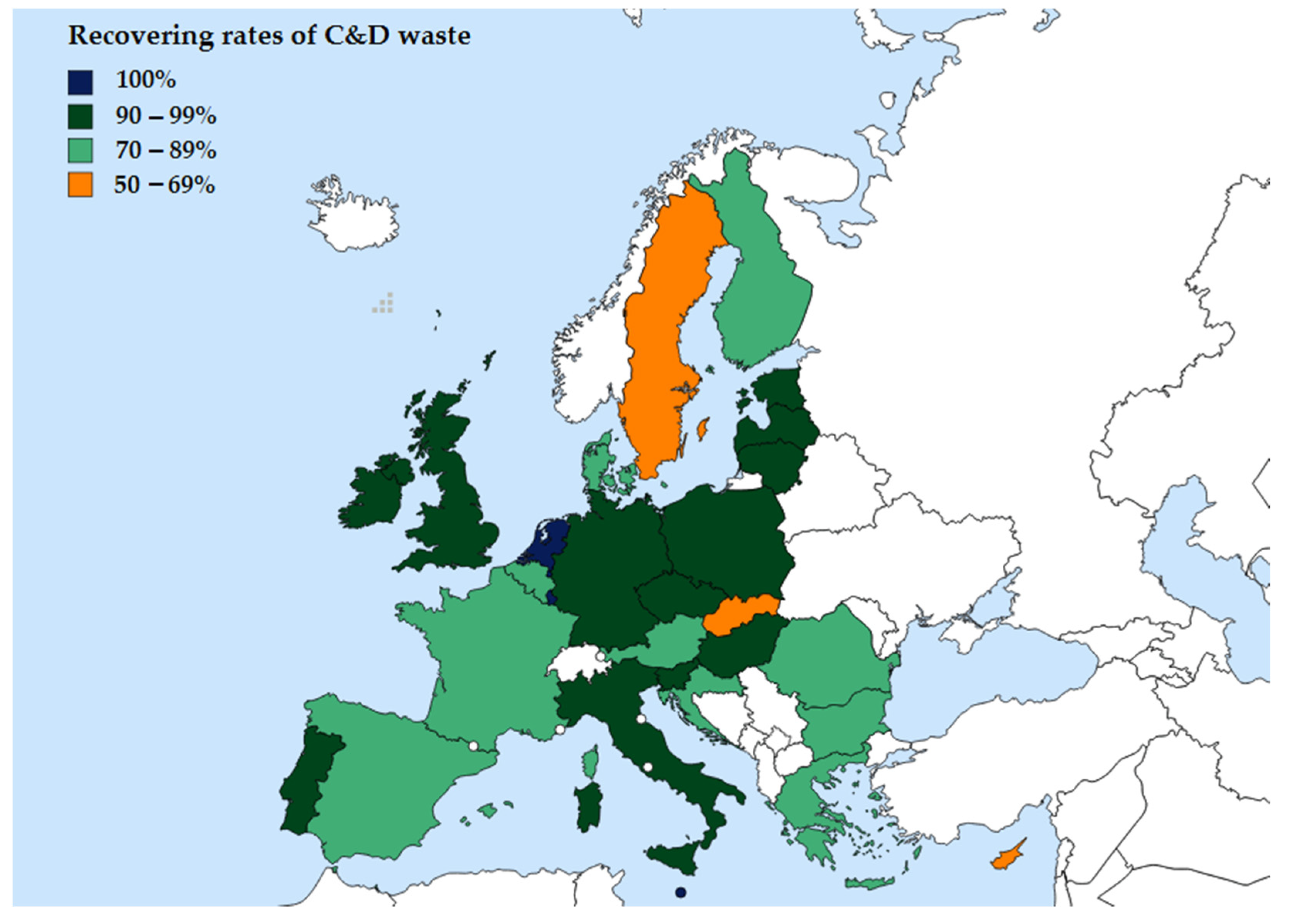
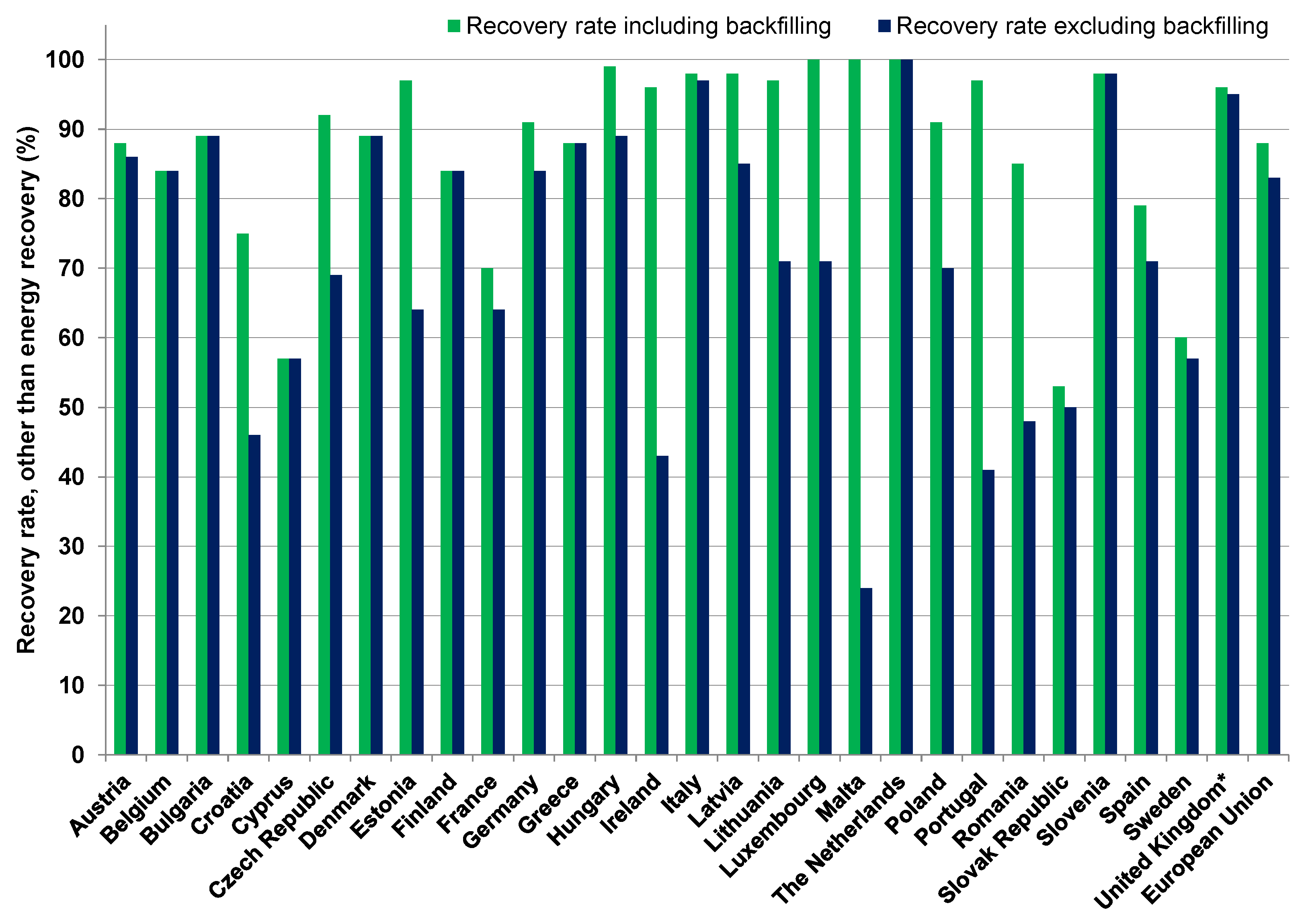
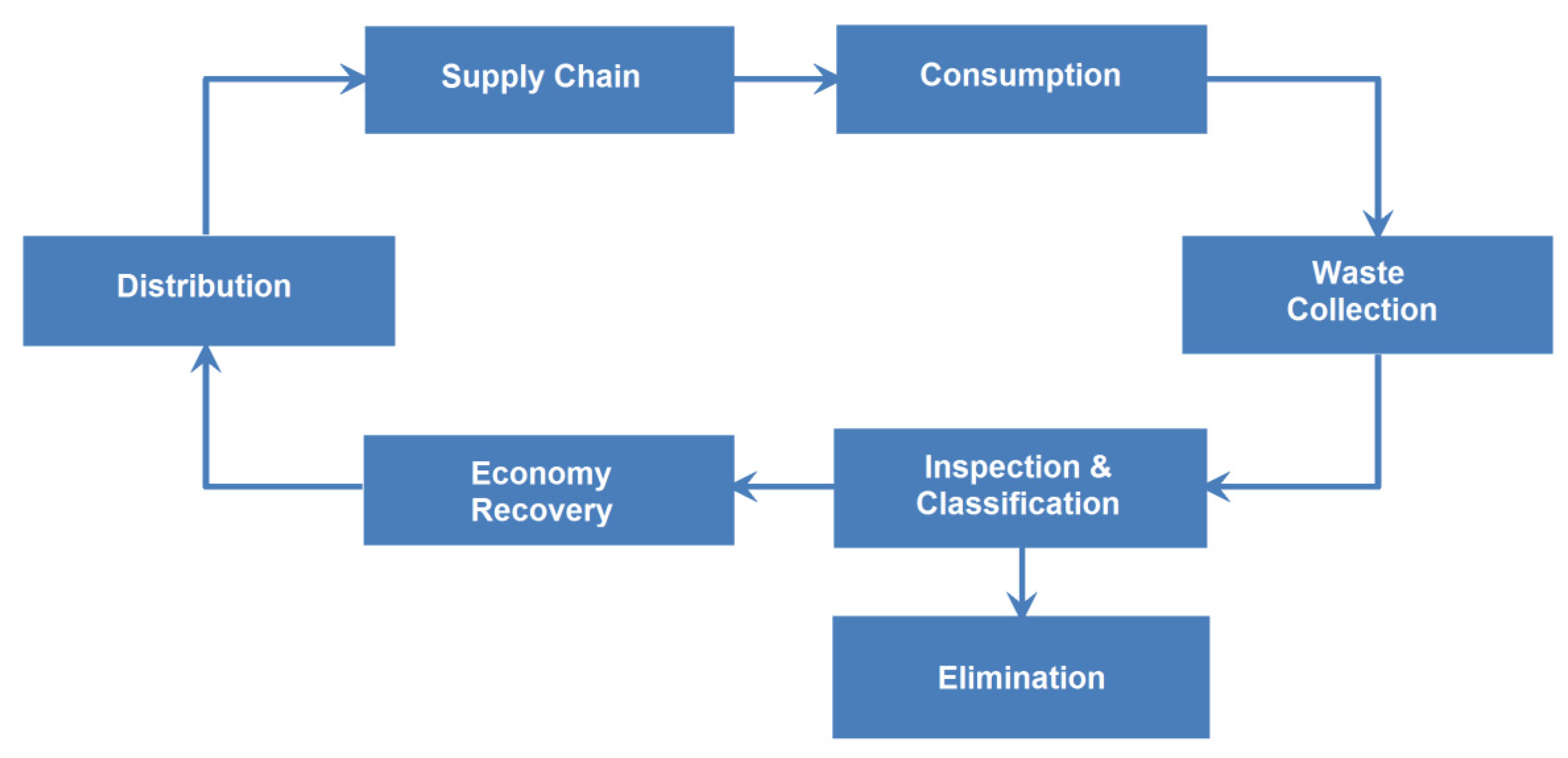
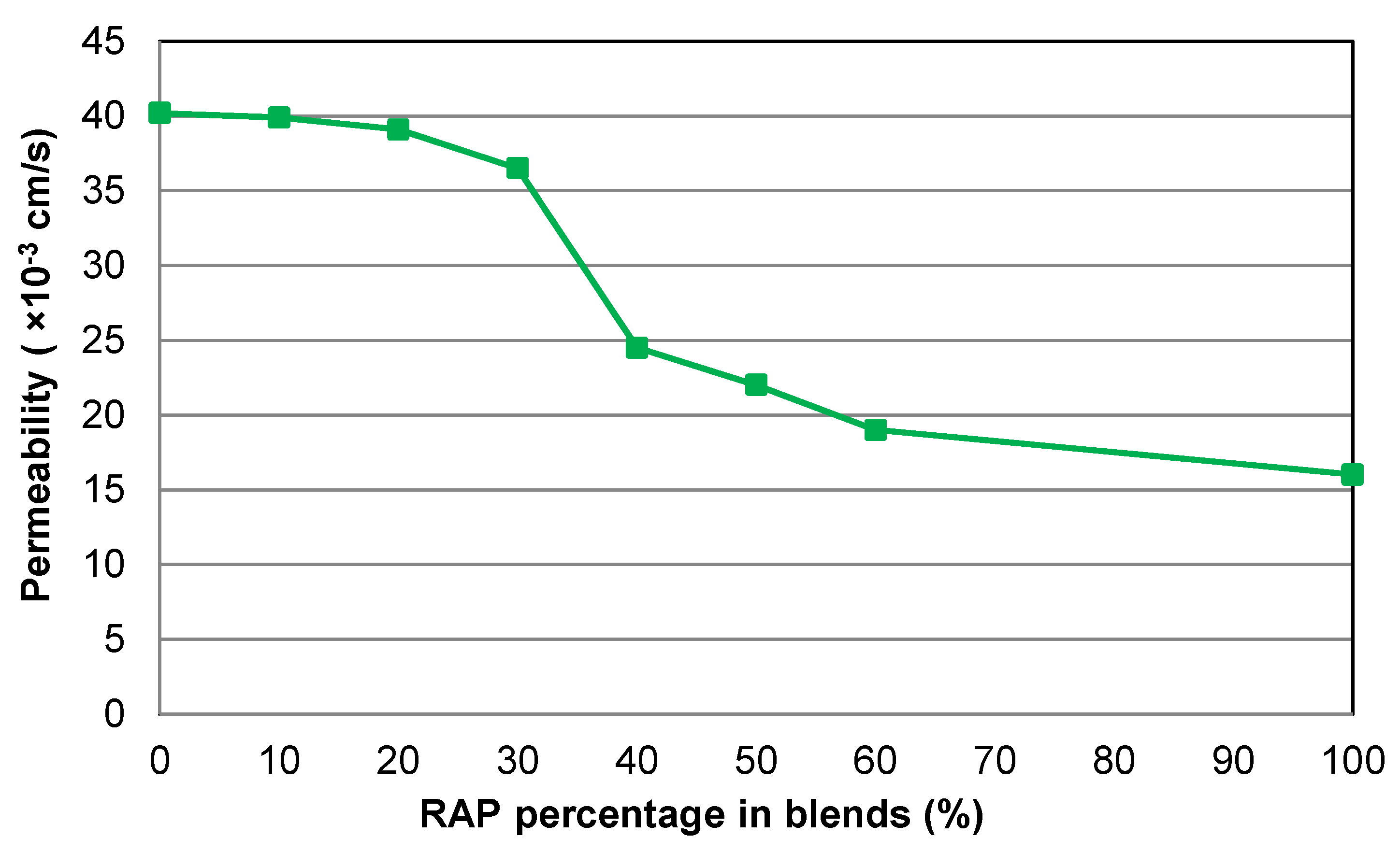
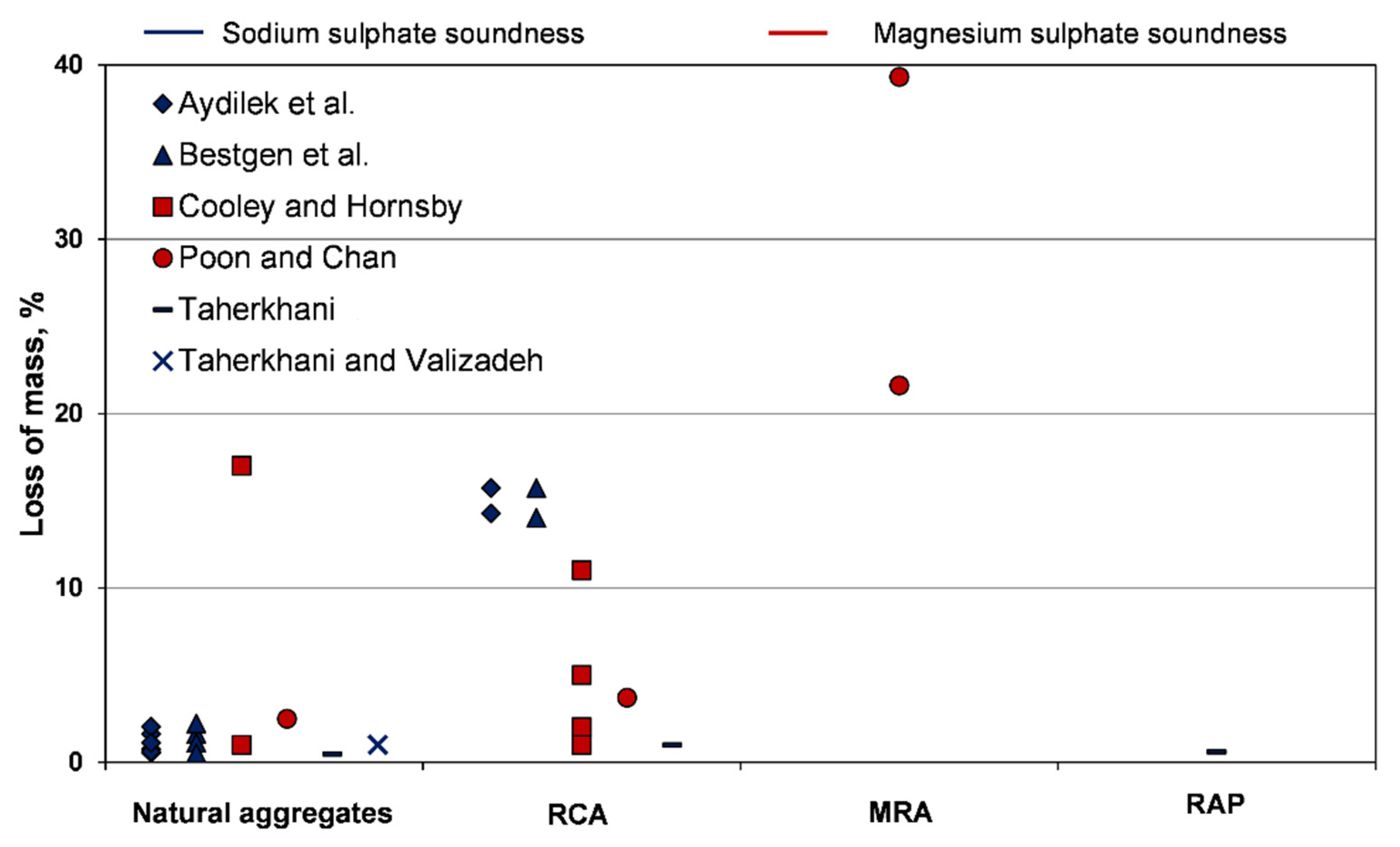
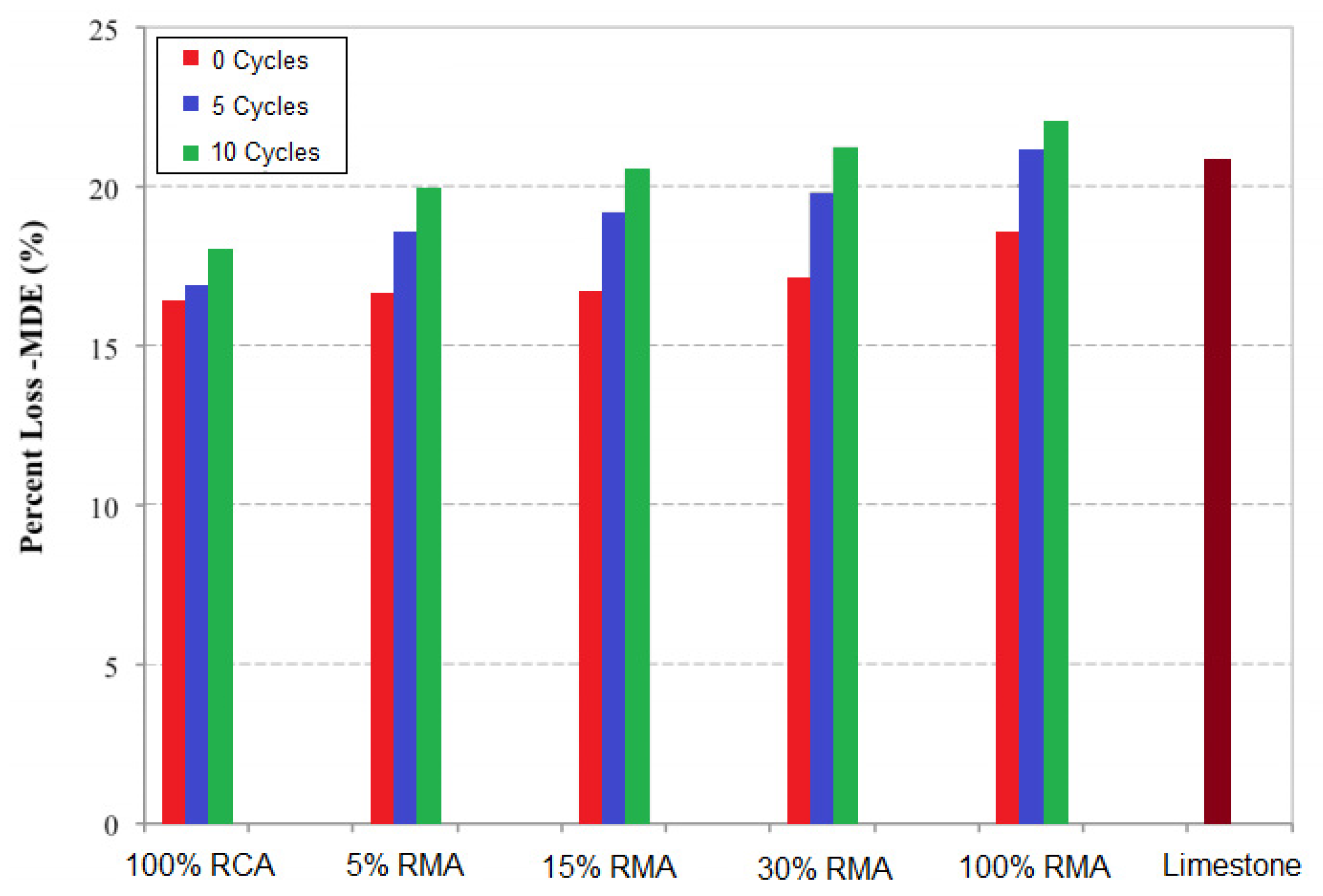

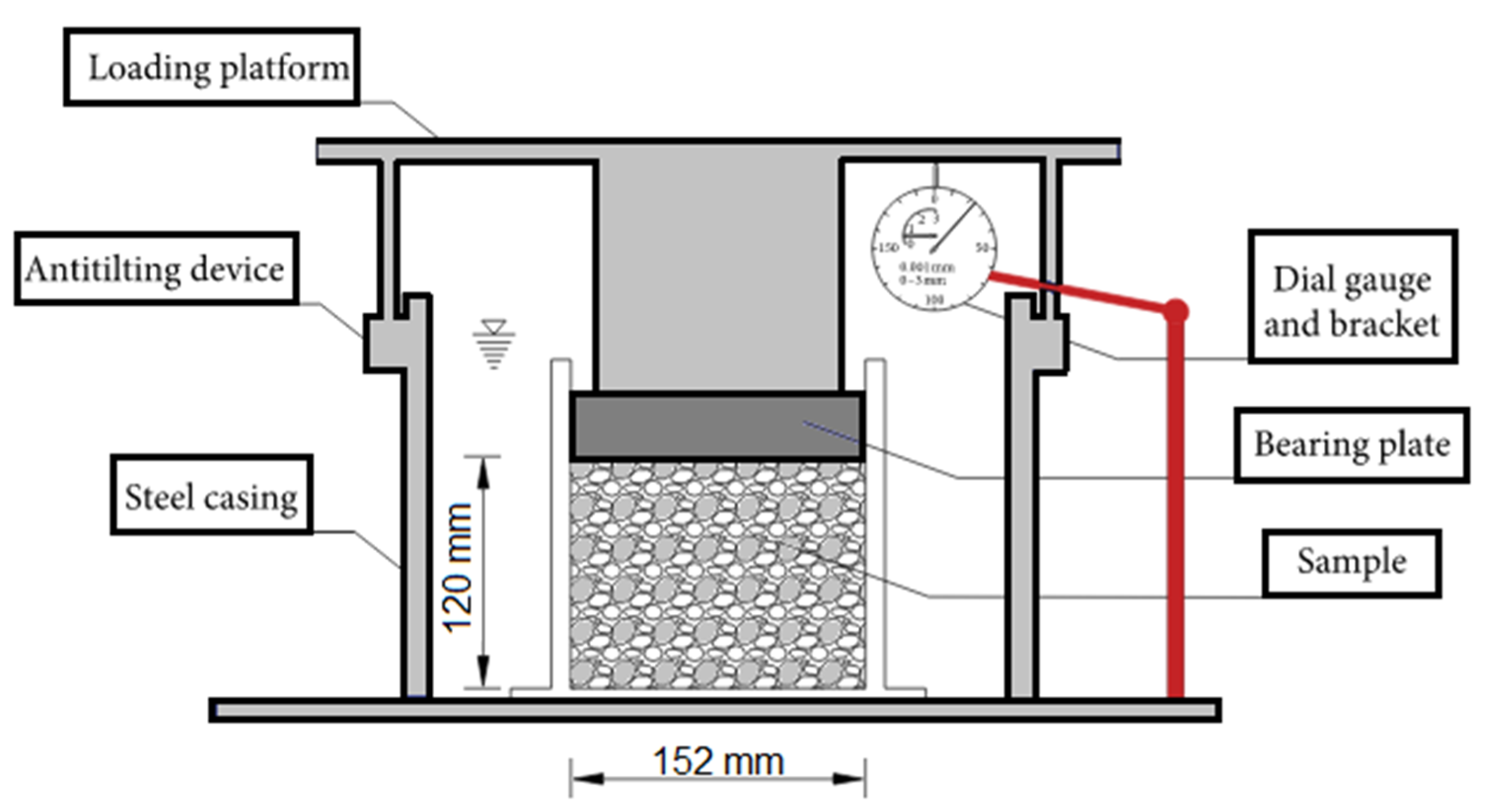
| Waste Category | Minimum Percentage (% w/w) | Maximum Percentage (% w/w) |
|---|---|---|
| Concrete and Masonry (Total) | 40.0 | 84.0 |
| Concrete | 12.0 | 40.0 |
| Masonry | 8.0 | 54.0 |
| Asphalt | 4.0 | 26.0 |
| Others Mineral Waste | 2.0 | 9.0 |
| Wood | 2.0 | 4.0 |
| Metal | 0.2 | 4.0 |
| Gypsum | 0.2 | 0.4 |
| Plastics | 0.1 | 2.0 |
| Miscellaneous | 2.0 | 36.0 |
| Country | Total Weight C&D Waste Generated (Million Tonnes) | % Recovery (Recycled and Backfilling) |
|---|---|---|
| Austria | 11.43 | 88 |
| Belgium | 22.28 | 84 |
| Bulgaria | 0.16 | 89 |
| Croatia | 0.64 | 75 |
| Cyprus | 0.33 | 57 |
| Czech Republic | 7.47 | 92 |
| Denmark | 4.61 | 89 |
| Estonia | 1.21 | 97 |
| Finland | 1.72 | 84 |
| France | 73.37 | 70 |
| Germany | 90.73 | 91 |
| Greece | 1.44 | 88 |
| Hungary | 3.50 | 99 |
| Ireland | 0.73 | 96 |
| Italy | 46.29 | 98 |
| Latvia | 0.39 | 98 |
| Lithuania | 0.82 | 97 |
| Luxembourg | 0.59 | 100 |
| Malta | 1.91 | 100 |
| The Netherlands | 22.22 | 100 |
| Poland | 7.37 | 91 |
| Portugal | 1.67 | 97 |
| Romania | 0.74 | 85 |
| Slovak Republic | 0.82 | 53 |
| Slovenia | 1.08 | 98 |
| Spain | 14.70 | 79 |
| Sweden | 3.40 | 60 |
| United Kingdom * | 71.29 | 96 |
| EU | 392.92 | 88 |
| Circular Economy Initiatives | Highlights/Goals |
|---|---|
| Towards a circular economy: A zero waste programme for Europe COM/2014/0398 [36] |
|
| Closing the loop: An EU action plan for the circular economy COM/2015/0614 [38] |
|
| EU Construction & Demolition Waste Management Protocol [28] |
|
| EU Waste Audit Guideline [39] |
|
| Level(s)-European framework for sustainable buildings [40] |
|
| Properties | RCA | RMA | MRA | RAP | Natural Aggregates |
|---|---|---|---|---|---|
| Specific gravity | 2.05–2.85 | 1.67–3.08 | 1.92–2.62 | 1.90–2.47 | 2.42–3.11 |
| Flakiness index (%) | 6.0–21.0 | 10.0–28.5 | 5.90–40.0 | 5.0–23.0 | 8.0–18.0 |
| LA abrasion loss (%) | 18.0–42.0 | 30.4–43.0 | 27.0–51.5 | 34.1–43.1 | 13.1–30.1 |
| Micro-Deval (%) | 10.0–34.0 | 18.0–23.5 | 16.0–20.3 | 7.5–25.0 | 6.6–22.0 |
| Maximum dry density (kN/m3) | 17.1–21.1 | 16.4–20.1 | 17.3–20.8 | 18.4–20.0 | 18.0–23.3 |
| Optimum water content (%) | 8.6–15.8 | 10.7–15.4 | 8.7–21.5 | 2.1–8.1 | 5.2–7.1 |
| CBR (%) | 19–215 | 45–157 | 26–150 | 19–39 | 36–170 |
| Cohesion (kPa) | 0–155 | 0–88 | 10–20 | 0–60 | - |
| Friction angle (°) | 40–66 | 42–58 | 42–52 | 33–60 | 30–60 |
| Water-soluble sulphates (%) | <0.38 | < 0.93 | <3.93 | <0.20 | <0.20 |
| Hydraulic conductivity (m/s) | 8.0 × 10−9– 2.0 × 10−6 | 0.5 × 10−9– 6.5 × 10−6 | 6.5 × 10−9– 2.0 × 10−5 | 5.0 × 10−8– 7.0 × 10−6 | <10−8—clay (impermeable) 10−8–10−7–silt (poor drainage) 10−7–10−6—silty sand (poor drainage) >10−6—fine sand (good drainage) |
| Properties | Data Range |
|---|---|
| D10 (mm) | 0.01–0.032 |
| D50 (mm) | 0.65–2.1 |
| Particles density | 2.58–2.72 |
| Methylene blue value (g/kg) | 1.0–3.2 |
| Maximum dry density (kN/m3) | 17.8–20.1 |
| Optimum water content (%) | 6.6–12.5 |
| Friction angle (°) | 34.4–45.9 |
| Cohesion (kPa) | 6.0–29.7 |
| pH | 7.8–8.9 |
| Authors/ Reference | Material & Mixture | Permeability (×10−3 cm/s) | Quality of Drainage [107] |
|---|---|---|---|
| Bennert and Maher [106] | 100% Coarse natural aggregate | 27.0–60.0 | Fair/Good |
| 75% Coarse natural aggregate/25% RCA | 27.0 | Fair | |
| 50% Coarse natural aggregate/50% RCA | 23.3 | Fair | |
| 25% Coarse natural aggregate/75% RCA | 23.0 | Fair | |
| 100% RCA | 0.1 | Poor | |
| 75% RCA/25% RAP | 0.4 | Poor | |
| 50% RCA/50% RAP | 1.8 | Poor | |
| 25% RCA/75% RAP | 0.2 | Poor | |
| 100% RAP | 6.0 | Fair | |
| Poon et al. [64] | 100% Natural aggregate | 229.0 | Good |
| 100% RCA | 267.0 | Good |
| Quality of Drainage | Minimum Permeability (×10−3 cm/s) | Time for Pavement to Drain |
|---|---|---|
| Excellent | 352.8 | 2 h |
| Good | 30.0 | 1 day |
| Fair | 3.9 | 1 week |
| Poor | 0.2 | 1 month |
| Very Poor | 0.007 | Water will not drain |
| Authors/ Reference | Recycled Aggregates | Procedures | % Loss of Mass and Other Mechanical Performances |
|---|---|---|---|
| Blankenagel [63] | RCA | Samples were cured for 7 days; Standard: ASTM D560 [111]. Freeze-thaw cycles: 13. | RCA loses 35% of its stiffness. |
| Chidiroglou et al. [70] | RCA RMA | Standard: EN 1367-1 [112]; Freeze-thaw cycles: 10. | RCA found a 10–15% reduction in ACV and AIV *; RMA showed a decrease in ACV and AIV by 11% and 8%, respectively *. |
| Ashtiani and Saeed [79] | RCARMA | Samples were immersed in 3% NaCl solution for 24 h prior to testing; Freeze-thaw cycles: 5. | RCA experienced 22–25% weight loss; RAP experienced a weight loss of 0.7–9.5%; Natural aggregates lose less than 1% of weight. |
| Diagne et al. [110] | RCA MRA | Standard: Modified ASTM D6035 [113]. Freeze-thaw cycles: 20. | RCA found a 7% reduction in constrained modulus. MRA showed a greater reduction in modulus than RCA and the reduction increased with increasing clay brick content. |
| Soleimanbeigi et al. [92] | RCA RAP | Samples were compacted to 95% γd,max. Standard: ASTM D6035 [113]. Freeze-thaw cycles: 20. | RCA resilient modulus decreases after 5 cycles, beyond which it increases about 28–36% more than its original value. Approximately 30% reduction in the resilient modulus of RAP Approximately 18% reduction in the resilient modulus of natural aggregates |
| Authors/Reference | Most Relevant Conclusions |
|---|---|
| Arm [119] | The FWD tests showed that the RCA sections demonstrated equivalent performance to the natural aggregates section. |
| Park [48] | The deflection of the RCA section was similar to that of the natural aggregates section. |
| Lancieri et al. [65] | Section built with MRA showed an improvement in performance over time compared to sections built with natural aggregates, due to their self-cementing properties. |
| Ho et al. [67] | The base course produced with RCA had lower deflection values than the base course produced with natural aggregate. |
| Lee et al. [122] & Lee et al. [120] | The results of the IRI and deflection showed that the road sections made of RCA had similar performance to the sections made of natural aggregates. |
| Jiménez et al. [121] | The deflection of the section built with RCA was slightly higher than that of the section built with natural aggregates. |
| Neves et al. [21] | In situ loading tests revealed that recycled materials (MRA and RAP) behave differently than natural aggregates, but it could be admitted that, in general, all the recycled materials showed acceptable performance. |
Publisher’s Note: MDPI stays neutral with regard to jurisdictional claims in published maps and institutional affiliations. |
© 2022 by the authors. Licensee MDPI, Basel, Switzerland. This article is an open access article distributed under the terms and conditions of the Creative Commons Attribution (CC BY) license (https://creativecommons.org/licenses/by/4.0/).
Share and Cite
Pereira, P.M.; Vieira, C.S. A Literature Review on the Use of Recycled Construction and Demolition Materials in Unbound Pavement Applications. Sustainability 2022, 14, 13918. https://doi.org/10.3390/su142113918
Pereira PM, Vieira CS. A Literature Review on the Use of Recycled Construction and Demolition Materials in Unbound Pavement Applications. Sustainability. 2022; 14(21):13918. https://doi.org/10.3390/su142113918
Chicago/Turabian StylePereira, Paulo Miguel, and Castorina Silva Vieira. 2022. "A Literature Review on the Use of Recycled Construction and Demolition Materials in Unbound Pavement Applications" Sustainability 14, no. 21: 13918. https://doi.org/10.3390/su142113918






